
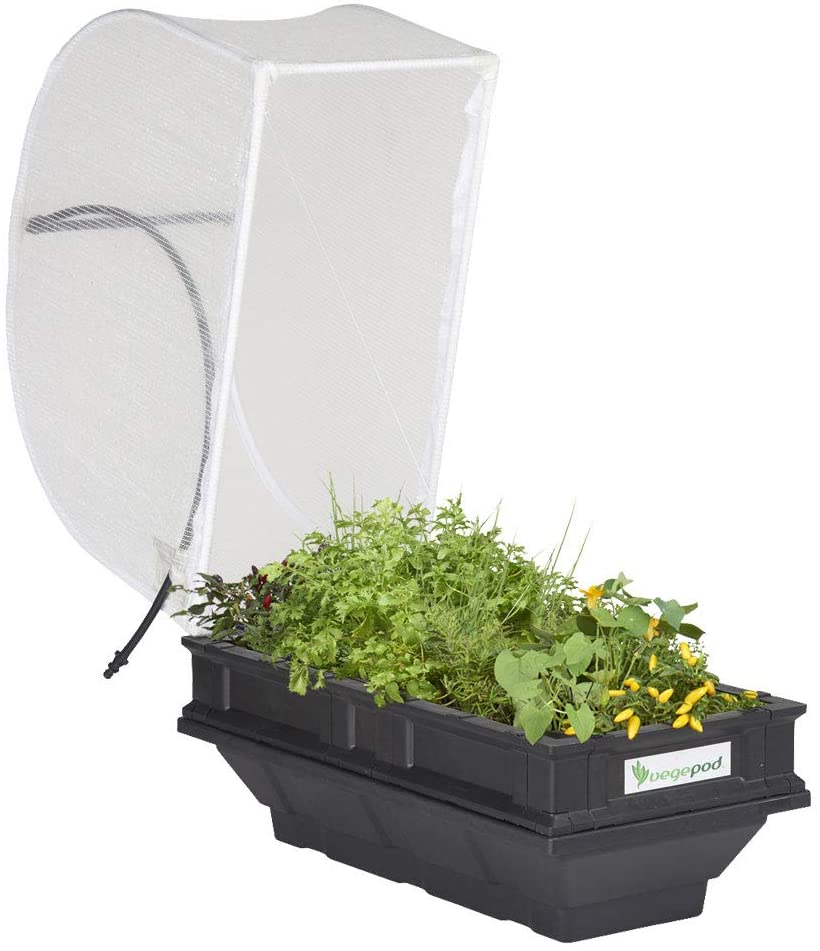
Raised beds for garden. Raised bed gardening can be defined as the act of growing plants that is place higher than the ground. The soil is placed with a frame made of concrete, stone, or wood.
The cost of building a raised bed for the garden assemble will be determined by how elaborate you build it. On how to maintain them compared to traditional gardens is similar, and they provide many benefits.
The benefits of raised beds for the garden
1. Look nice
Growing herbs, flowers, or vegetables with a raised garden bed will make everyone happy. It looks beautiful with a raised garden bed compared to the typical garden. Raised beds are more comfortable to maintain because there’s a separation between the path and the bed.
2. No need for tiling
A raised bed is really an easy way of making your soil without tilling up the soil from time to time to add organic material or amendments or fertilizer. With your raised beds, you are simply adding elements on top.
When you grow beans, you add seaweed mulch to the topsoil for weed prevention and adding nutrients. You do not need to work the soil to add manures, compost, or mulch.
Worms and roots will tile the soil naturally. Regular tilling tends to deplete the soil structure.
3. Good for back and knee issues
People with knee and back issues can suffer by weeding a garden. A raised bed for the garden can help people with back and joint pain—no need to kneel, crouching or straining.
4. Better drainage
The most in-depth for a raised bed is eleven inches. For many plants, this is adequate drainage. For plants, it provides a foot of extra breathing room above wet conditions. Raised beds drain better in general compared to a regular garden, even in heavy rains.
5. You will have fewer weeds and crabgrass
When you tile the soil, it creates more weeds. Tiling buries weed seeds and allows them to propagate. Cover the beds with black plastic, cardboard, or mulch in the spring months to kill all the weeds that grew up in the winter months. When begin to plant, eliminate the dead weeds. You can install a weed barrier on the bottom of raised beds to prevent the crabgrass from infiltrating.
6. Good choice for beginners
Raised beds can guarantee success for beginners in the first year of gardening. All you have to do is to prepare the plant to grow, soil, compost, seeds, water, and a box.
7. No contaminated soil
Many vegetables like greens, roots, and tomatoes absorb heavy metals from contaminated soils. You can relocate beds away from the road to help avoid getting toxic. Toxic that contaminate soil can be reduced by adding compost on the topsoil.
What are the best raised beds for the garden?
[wptb id="3841" not found ]1. Rhino Garden Supply Vertical Raised Beds For The Garden
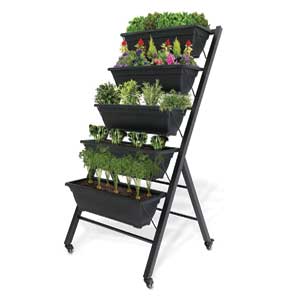
Rhino Garden Supply makes this vertical garden bed kit. This garden bed is suited for your balcony gardening.
You can plant and grow tomatoes, flowers, vegetables, and herbs. It would make a beautiful exterior design.
It comes with four swivel wheels with locks. If you like to relocate to a more beautiful place, you can move the garden bed anywhere you want.
The planter boxes have five drainage holes to eliminate the risk of getting root rot. The planter is thicker, food-safe, polypropylene, and BPA free.
The frame of the garden bed is made from heavy-duty steel. This material will make the frame las for a lifetime.
The frame is also gets baked on at four-hundred degrees, and grade powder-coated finish.
Pro :
Con :
2. 6-Ft Raised Garden Bed – Vertical Garden Freestanding Elevated Planter with 4 Container Boxes
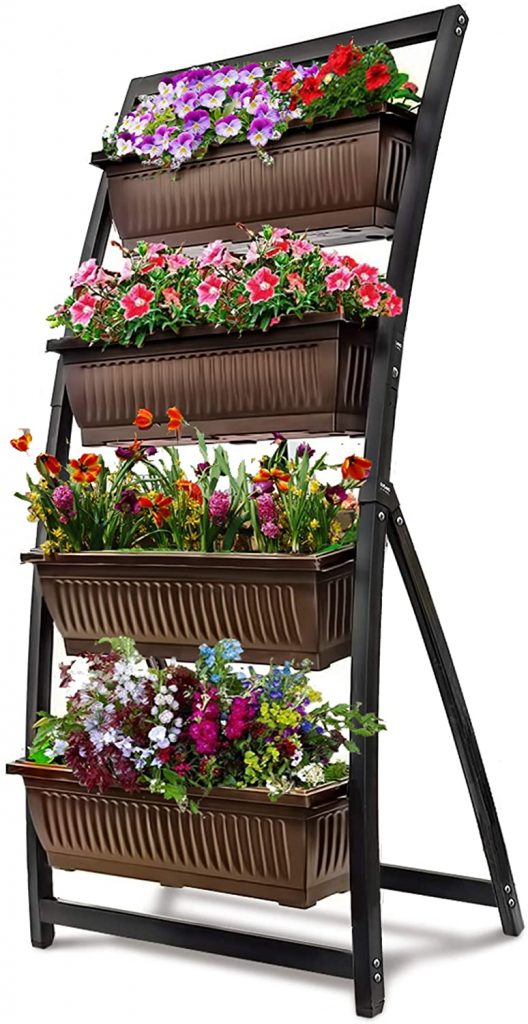
You can start your planting quickly after you assemble the vertical garden beds. You follow the instructions included.
You can place these planters with small space because each hanging plastic box container is twenty-seven inches. The raised beds can be placed in your small apartment, patio, balcony, or a small garden.
You can plant and grow numerous vegetables, herbs, flowers, seeds, and succulents in the area at home without having ample space. The planter’s plastic bins are made from food-safe, BPA free, lead-free, and mercury-free.
It has a Cascading Water Drainage that will water flow from the top down to make sure all plants are watered well. The raised beds for the garden are very suitable for older people or people with back issues.
Pro :
Con :
3. Keter Urban Bloomer 22.4 Gallon Raised Garden Bed with Self Watering Planter Box and Drainage Plug
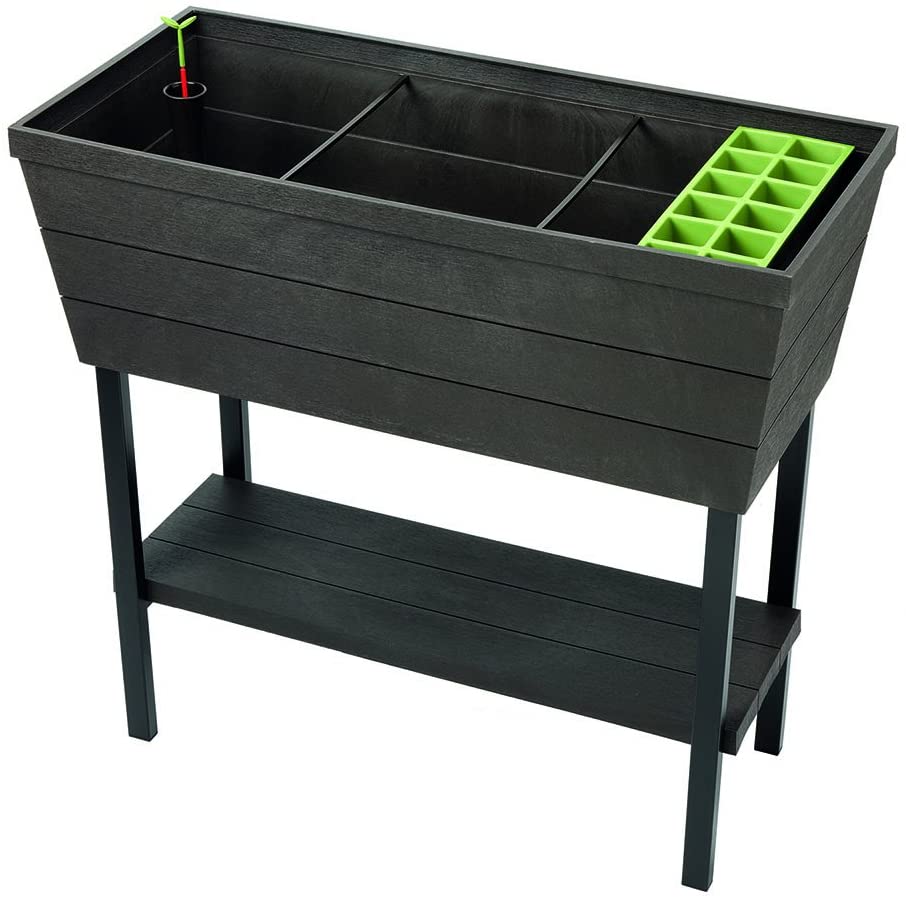
If you like to do gardening with convenience, this modern design garden bed is the right choice for you. You can enjoy your activities while walking onto to your garden or patio or deck or balcony to pick your vegetables.
Other than those people with chronic pain and arthritis will benefit from its ergonomic design. If you have those diseases, you do need no worry about doing the straining or kneeling or crouching to do gardening tasks.
It comes with a seed sprouting tray to cultivate seedlings and seeds. With these garden beds, you can monitor when to water your plants. A water gauge designed to show you that when it is red, it is time to drain. Because there is too much water when it is green, it is time for you to water.
The key benefit of this garden bed is a smart watering system to retain soil at maximum moisture concentrations, and at the same time preventing overwatering and root decay. When it is time to drain the excess of water, a drainage tap can bring your planter indoors without leaks.
Pro :
Con :
4. Foyuee Raised Planter Box Garden Bed On Wheels
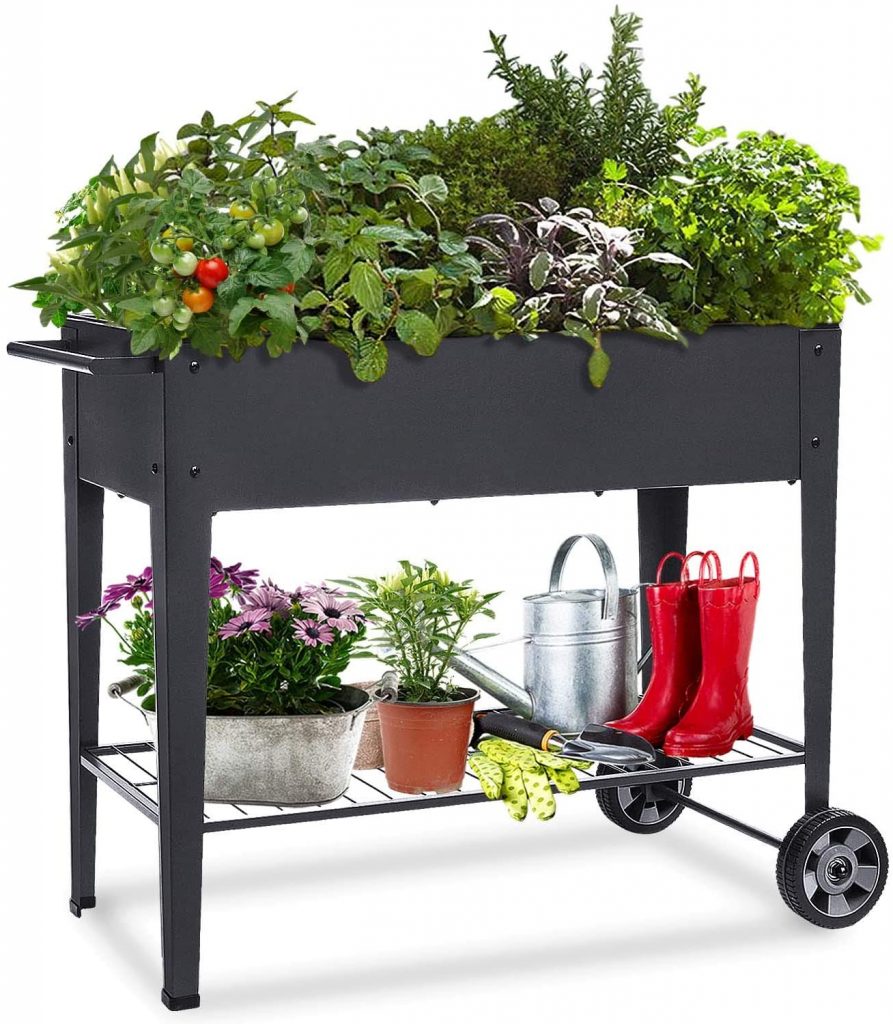
If you ever worried about the rust that may get to your planter, this raised garden bed can solve your problem. This garden bed is made from galvanized steel with anti-rust black coating to protect the garden bed from corrosion and rust.
The elevated garden bed planter from Foyuee has adequate room to grow tomatoes, herbs, and flowers. The dimension of the planter is suited for small outdoor spaces, and you can save space.
For people with a mobility issue, this ergonomic design can help them. Its wheel and handle design will make the planter easy to move anywhere.
You can control the root rot or waterlogging issue with its drainage line. The durable, sturdy, and stylish built is for use over many years.
It comes with a handy shelf that holds accessories or tools as needed.
Pro :
Con :
5. Watex Mobile Elevated Garden Bed
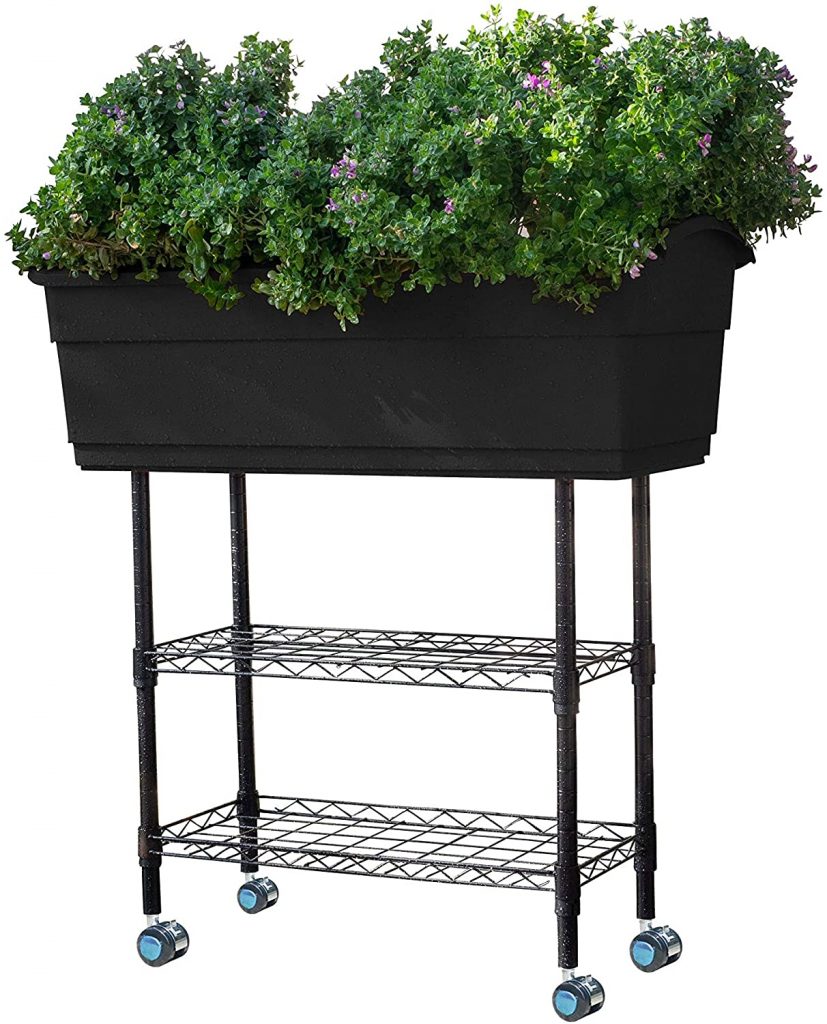
The Watex Elevated Mobile Planter will help those people with knee or back problems. They do not have to hurt or bend thair backs or knees.
You can place the mobile planter in small space gardening for your decks, your patio, your yards or your balcony. You can grow herbs, vegetables, flowers or other plants with this planter.
You can move the planter using its wheels when it is time to move it to shade or sun or keep away from harsh weather. It has a self-watering system to reserve water in the bottom of the planter so you do not have to water the plants daily.
You can benefit from a moisture gauge or water level indicator that gives you a sign that you are not overwatering your plants. Watering the plant can start again once the water level is below or close to the minimum water level.
Pro :
Con :
6. Vegepod – Raised Garden Bed – Self Watering Container Garden Kit with Protective Cover

Do you want to grow your vegetable? This Vegepod Raised Garden Bed Kits will help you to achieve that with a natural solution.
The soil and the reservoir will be contained not only recycles water but the soil nutrients as well. If you use a potting mix, it will stay for years to come.
The self-watering system that it provides utilizes a wicking system in which the soil draws the water upwards to keep the soil moist. You do not have to water the plant for weeks, and in cold weather, the plant will not need water for many months.
Each planter comes with a Vegecover that covers and protects the plants from pests, bugs, sun, frosts, and winds. This planter product can help the plant having micro-climate for better growth rates compared to another planter.
This planter product is made from recyclable and food-safe Virgin Polypropylene Plastic. You do not even have to worry about your limited space, and it can be placed on your porch or patio or indoor or garden or your balcony.
Pro :
Con :
7. Giantex 3 Tier Wooden Elevated Raised Garden Bed Planter Kit
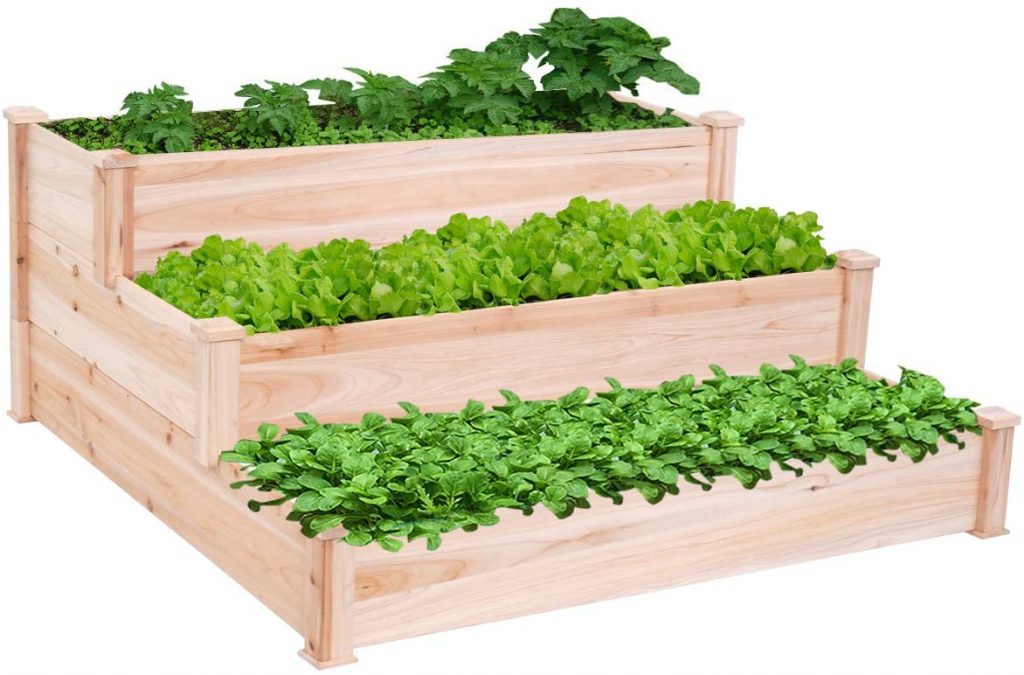
This garden bed is made from the long-lasting frame and durable cedarwood. Cedarwood does not expand when there is a change in weather or moisture.
The wood is also a stable wood that does not crack easily. It is strong enough to support the weight of the plant, the soil, and the garden bed.
You can grow deep-rooted plants and vegetables in the top two-layer. While the bottom layer is for the other plant. The garden bed is suitable for flowers, vegetables, and herbs.
The moisture would be maintained inside the garden bed. It depends on you where to place the garden bed. It can be placed in your garden or porch or garden or yard or decks or balcony.
Pro :
Con :
8. Yaheetech Raised Garden Bed Kit

The raised garden bed product by Yaheetech is made of fir wood. It does not have a painting finish and non-toxic.
While doing the gardening tasks, you do not have to worry about wood splinter because the boards are sanded. The thick solid wood boards are fixed and joined by screws.
If you want to plant different plants, you can place the plants into two separate growing areas. On the one area side, you can plant vegetables while on the other area you can plant herbs.
You can quickly assemble and set up with the included accessories, and instructions are included. You do not even have to care and maintain the garden bed because it is built to last.
Pro :
Con :
What to prepare or consider when planting with a raised bed?
If you plan to build a raised bed garden, You will not require to own a large space. What you should consider is to locate a spot that gets full sun for at least six hours in one day.
Plants should be provided with lots of suns to set fruit and to mature fully. The best location for a raised bed garden is the sunniest area on your property.
Avoid shaded areas where there are trees. Pruning these trees to allow the sun to reach your garden spot is the best practice.
1. Level area
If you have hilly terrain of your backyard, dig into the hill to get that mountainous area to become as level as possible. You have to remember if you can not level the terrain, you can make the raised bed surfaces to be level.
2. Near water source
Water is the most important factor for gardening success. If you can not find any water source, you must lay a spigot near the garden area.
3. Environmental conditions
If the selected spot is in an area that receives heavy rain, inspect how the rain will impact your garden bed structure. Think about how to make runoff of the heavy rain to go around the garden bed area.
You need to avoid having a site of your garden bed where water tends to pool on your property. A pooled water can wick up into the garden beds and drown your plants.
4. Predators
You need to have fence planning to keep away raccoons or deers. Predators can be discouraged if you keep the garden bed close to your home.
What is the size consideration of the garden bed?
1. The height
A 6-inch garden bed is the lowest but still productive and works well. The twelve-inch and eighteen-inch are ideal because most feeder roots are in the first six-inch.
Higher than eighteen-inch can cause structural issues due to the pressure and weight of all that soil. Plan about what types of plants will be grown. Vegetable roots require more space, and herbs require less space.
Provide as much and practical room as possible for your plant roots to grow.
2. Width
The ideal width of the garden bed is between three to four feet. If you considering four feet, the garden bed will let you have more flexibility for spacing rows. The width will enable you to reach the center from either side of the bed without hassle. Do not step into the bed that will compact the soil, affect drainage, and overall health.
3. Length
For the length of your garden beds, you can build whatever you need. You could create four times four square-inch or four times twenty square-inch rows. You need to stick within a four-foot maximum width. Your budget and your garden space only limit the length.
4. Shape
You can shape your garden beds as ovals, circles, squares, and rectangles. The shape of the garden bed will not matter as long as you can reach all areas from the edge of the garden bed.
What is the material of a garden bed?
1. Treated wood
Treated wood is a kind of timber infused with chemical elements to provide the wood a long-lasting life. Chromated Copper Arsenate (CCA) wood is the most used for a garden bed.
Studies about the impact of treated wood for raised beds have shown that touching the exterior of the bed is the highest risk of getting copper. When people sit on treated wood, the clothing is to absorb the copper or arsenic.
For using CCA-treated wood for a garden bed, you can apply much compost, and plants will not take up arsenic unless the soil contains less phosphorus. If you apply much organic matter on healthy soil, the arsenic will not be absorbed by plant roots.
2. Concrete blocks
All concrete blocks are made of Portland cement as well as sand or gravel. One ingredient of Portland cement is fly ash. It is used for making concrete blocks stronger but lighter.
Fly ash contains numerous amounts of toxic metals such as mercury, arsenic, and lead. The risk of those metals will be available in the soil if part of the concrete block is pulverized.
Avoid anything that would break any part of the concrete block that the dust from pulverized pieces can touch the plant roots. You can also seal the interior lining with a polymer paint, or line the interior side with PE plastic.
3. Galvanized metal
The risk of using galvanized metal is low in the use of raised garden beds.
It may exposed zinc in small quantities.
Zinc is a micronutrient that plants need in small quantities. If too much zinc were exposed to the soil, plants might die.
What you have to remember are drainage and heat. It is critical to provide many drainage holes in the bottom of the raised bed made of galvanized metal. The hole will let moisture escape.
Metal will reflect and absorb heat from the sun. The soil will dry out more quickly. This will make the leaves turn to yellow.
It is best to plant vegetables toward the center of the garden bed where soil temperature will remain mostly constant.
4. Liners
There are so many plastics with widely-diverse safety grades. If you use plastic for your garden bed, look for food-grade polyethylene.
It is one of the most food-safe plastics. Line only the outer side of the garden bed. Try not to block drainage with plastic.
5. Wood stain and paint
You may want to extend the life of your untreated wood by painting or staining it. Use a natural treatment like raw tung oil or raw linseed oil.
These chemicals function is to speed up the oil drying process.
Linseed oil may not be the best choice because it is a food source for mildew. To reduce risk, use chemicals of some nature and do not use chemicals that may impact your plants.
Frequently asked question
Do you have to change the soil in raised beds?
You should put down layers of compost, especially on the topsoil, to replace the depleted nutrients by the plants you have grown. There is no need to mix the compost and the soil because, as the compost decomposes, nutrients will be released to the soil.
Should I put rocks in the bottom of my raised garden bed?
By placing a rock in the bottom of a raised bed for the garden, it will provide well-draining soil and create additional drainage space below the soil. Drainage will expel excess moisture in the soil to eliminate root rot and prevent damage or kill plants.
How many bags of soil do I need for a 4×8 raised bed?
If your garden bed has a length of five-feet, a width of four feet, and a depth of two feet, the volume comes up with forty-cubic feet (5 x 4 x 2 = 40). Forty-cubic-feet is the amount of dirt needed to fill your raised planter box. You can purchase twenty bags of soil containing two-cubic-feet of dirt each.
Should I cover my raised beds in winter?
Leave the roots, and the roots will aerate and decompose the soil. Spread about five inches of compost on the topsoil. Next, cover the topsoil with mulch. The mulch cover and protects the soil during the winter months. The compost adds nutrients to the soil over the winter.
Do raised beds need drainage holes?
A raised planting bed for the garden uses height to flush the water to drain. Raised planters or garden beds do not have a base. The soil of the planter drains down to the topsoil on the ground.